Dirty gold is the color that smothers every surface of Sara Rahbar’s New York City studio. Disembodied casts of the artist’s own anxiously clenched hands and feet are laid out, clinically, on long tables alongside bullet casings, rifle butts, chains, and other found objects. With the same studied intensity that won her the art world’s lofty recognition for her earlier textiles, Rahbar spent the past two years with her ebony hair pulled back out of her face, hunched over these tables, teaching herself how to sculpt.
We held our interview in Dubai at Carbon 12, the gallery that represents Rahbar, which is tucked in a warehouse in the gritty industrial area of Al Quoz, a world away from the opulent hotels and skyscrapers that the city is best known for. We floated in swivel chairs over the gallery’s polished concrete floor, surrounded by Swarming, the show that represents the culmination of Rahbar’s first sculptures, and the marriage of 206 Bones and Confessions, two heavily loaded series addressing sociopolitical issues in America, from the high expectations and perceived failings of Obamacare, to the raw PTSD experienced by returning soldiers--a group the artist considers as part of the workforce. All of the materials for the sculptures—from sickles, to wheels, and wood—have been heavily used by workers and call into question civilization`s collective surge towards both everything and nothing.
In her unmistakably New York accent, Rahbar stubbornly suggested that although the show is personal, it does not deal with her childhood escape from Iran with her family, nearly dying in the mountains, then struggling to pull together a new identity in America. Though that story unfolds like a box office hit, it’s been over hashed in the media, and after thirty-five years spent in the United States, Rahbar rejects that narrative as having any influence on this latest work. Like a ghost, her refugee past has shadowed her whether she likes it or not in every interview she’s ever given.
Rahbar first became known for her Flags, a prolific, numbered series that consumed her for nearly a decade, and was the topic of a lecture delivered at The British Museum in October, following the acquisition of two works for the institution’s permanent collection. Rahbar rent, patched, and embroidered various textiles from Iran onto and into the American flag, reappropriating the traditional flag into a new kind of canvas. Interestingly enough, the series began as the artist’s desperate exploration of the tearing of her own family fabric, but was interpreted as political art, while Swarming is engaging directly with political and social issues—the stuff of public monuments presented in a gallery’s sterile white space.
Our conversation at Carbon 12 began nervously, progressed bluntly, and ended in laughter.
Danna Lorch (DL): Your sculptures introduce some distance between you and the flags you are best known for. Did you feel trapped artistically by the success and recognition of that early series?
Sara Rahbar (SR): I did for a minute, but I don’t feel trapped anymore. The flags came instinctively to me and I worked on them until I was complete with that conversation, and then I very naturally moved on.
DL: There are themes of labor and oppression evident in Swarming. Are you insinuating that modern capitalism invites a vicious cycle?
SR: The concept of swarming refers to a group of living things gathered in one place, whether it’s wasps, soldiers in an army, or the growing heartbeat of a revolution. There is a sense of tension in the cast hands and feet. When I get really nervous or angry, I clench my feet and my hands. These sculptures reference that frozen state of pain and anxiety. The two series are about modern day slavery, the laborer, soldier’s PTSD, and the everyday pain and violence that surround us all.
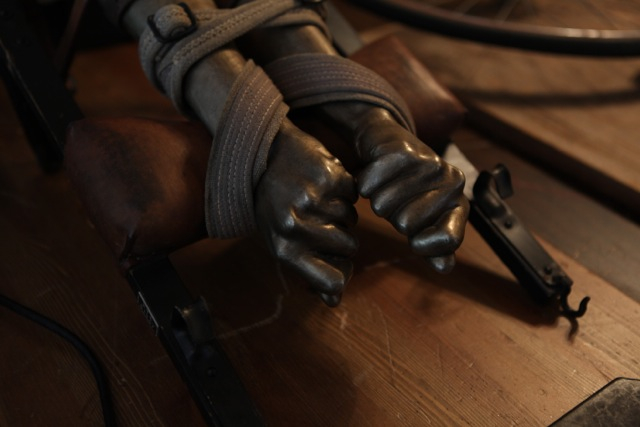 [Detail of work in progress inside Sara Rahbar`s studio, 2014. Photo credit Sueraya Shaheen.]
[Detail of work in progress inside Sara Rahbar`s studio, 2014. Photo credit Sueraya Shaheen.]
DL: If you’re a worker who is paid by the hour, you generally put your own needs and desires on hold for the good of someone else.
SR: The worker becomes part of a machine. It’s a trap, a prison. Accumulating money, and more and more of it, symbolizes freedom and having additional choices in life. This show is very personal for me, as all my shows are. It takes on these bigger conversations, but it’s all still to do with my life. I’m focusing on these subjects because they closely impact me.
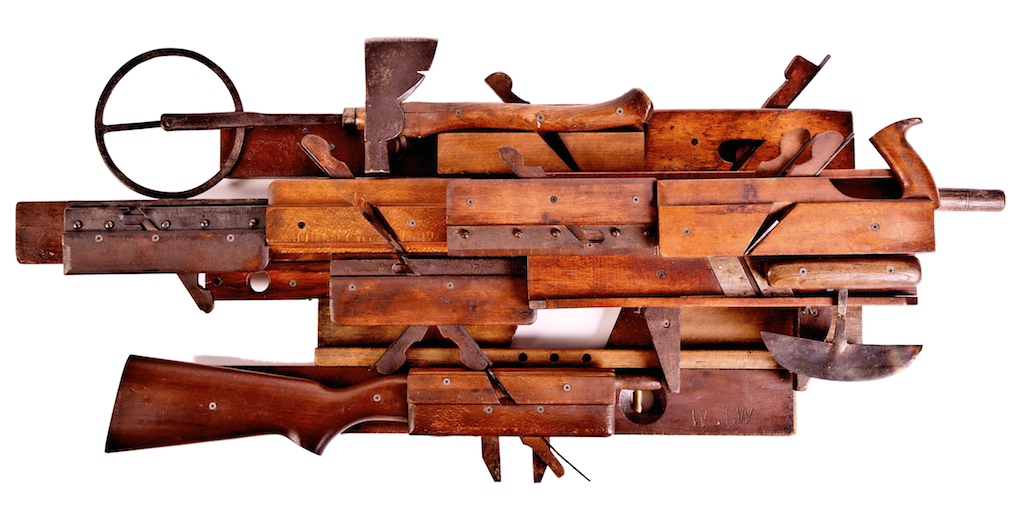 [Fragmented (2014), from the 206 Bones series. Image copyright Sara Rahbar. Courtesy of the artist and Carbon 12, Dubai.]
[Fragmented (2014), from the 206 Bones series. Image copyright Sara Rahbar. Courtesy of the artist and Carbon 12, Dubai.]
DL: How do you feel about being labeled as an Iranian artist? Are you comfortable or uncomfortable with that designation?
SR: Honestly, I’m very anti-label. My left eye twitches when I’m referred to as an “Iranian artist,” an “Iranian American artist,” or a “Female Iranian artist.” As a kid I visited the Metropolitan Museum of Art and was struck by the paintings of Francis Bacon and Lucian Freud. At the time I never knew where these artists came from or had any background information on them. It was simple—I encountered something visual, it moved me beyond words and I never forgot it. I hope that my work can surpass all these labels and speak a more universal language.
DL: So out of principle, you’re not interested in capitalizing off the latest art world buzz words, even if it grows your name?
SR: When people call me Iranian, it feels awkward sometimes because I am so disconnected from that culture. I’ve lived in New York for over 35 years now. It’s my home. I speak, think, and dream in English. My whole life has happened in the United States.
DL: Nothing left to win, nothing left to lose is particularly unsettling. How and why did the concept for the sculpture appear to you?
SR: I remember this game from my childhood that I used to play. A small object is hidden in a hand and then moved around behind the back. It’s a children’s game, and you have to try to guess whether the object has been concealed in the right or the left palm. This piece stemmed from that idea. It’s about empty promises and games people play. You think you’re holding onto something, but in reality you’re holding onto nothing. You never really own anything. It always owns you and it becomes a daily struggle just to sustain what is yours.
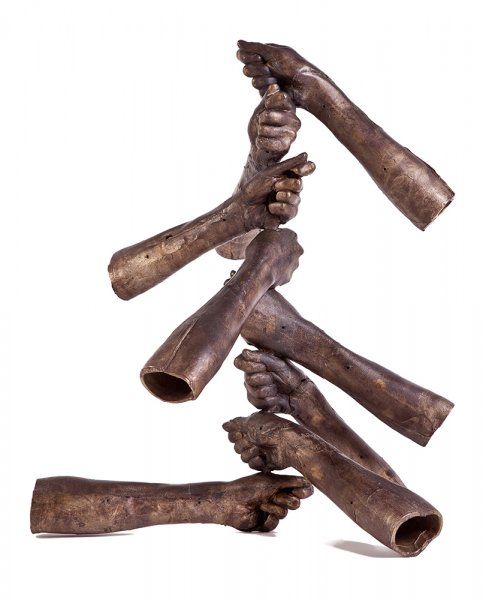 [Nothing left to win nothing left to lose (2014). Image copyright Sara Rahbar. Courtesy of the artist and Carbon 12 Dubai.]
[Nothing left to win nothing left to lose (2014). Image copyright Sara Rahbar. Courtesy of the artist and Carbon 12 Dubai.]
DL: You once said that you’d like for people to view your textiles and sculptures in the same way that they encounter a painting. Why did you suggest that?
SR: I said that because I work with collected objects from the eighteenth and nineteenth century, and I am always being asked to explain the history behind them. I don’t necessarily know the origins of my materials, or need to in order to be able to work with them. It’s not about that for me. I search for odd and interesting objects at flea markets and garage sales, throw them in a pile in the corner of my studio and then focus on arranging them by color and composition; moving them around until I find balance. Painting is where I began my practice and for me it’s still about color, composition, texture, and finding a beginning and an end.
DL: In terms of color, this newer work stays within shades of gold and brown. That’s quite a departure from the vivid textiles and embroidery of your flags.
SR: Sometimes I’m a little embarrassed when I look back at my earliest flags, or initial works in general. They were so bright. Now I need less to say more. I’m in love with dirty gold, black, and dark greens. I pour ammonia on the bronze to darken it. I want these pieces to look beat-up, dragged through the mud, scraped, and scratched. I want them to look like they have been to hell and back; I love imperfection.
DL: Every interview with you always starts off with the dramatic narrative of your family’s escape from Iran. Do you feel that your history is intimately connected to your artistic practice or does it take away from the strength of your work?
SR: I wonder if that portion of my biography is even relevant anymore. The work is about much more than that. Oftentimes in interviews I’m not asked about my past, yet the writer still inserts that portion of my life at the beginning of the article. I have moved on, so that narrative feels imposed.
DL: How were you taught to sculpt? Was it part of your graduate curriculum at Central St. Martins?
SR: I’d always wanted to do sculpture, but it can be expensive and challenging, it took me ten years to be able to begin and I’ve never been trained in any particular medium beyond sewing. At Central St. Martins they didn’t teach us how to make things, they taught us how to think. I had to figure the rest out on my own.
DL: Did you have any help in the studio or did you learn to do everything by hand yourself?
SR: I don’t have a crew of assistants helping me. I figure out how I’m going to do something by experimenting. The first time I drilled into wood for 206 Bones it split down the middle because it was so old and fragile. I worked with wood and bronze for over two years until I finally got a good sense of it. I’ve been working with textiles for ten and I know that there is still more to learn.
Since I don’t have an oven in my studio, I go to Modern Art Foundry in Queens. This foundry has been around for eighty years and was actually the place where Louise Bourgeois cast her first spider. I chose them because they let artists come and work for hours and that is very important to me as I need to be involved in the making own my own sculptures.
DL: Would you say that you nurture or beat yourself up in the studio?
SR: Since I was very young I was constantly questioning myself, and the world around me. That questioning has always been a vital part of my practice. Sometimes its smooth and sometimes its painful—it’s a rollercoaster ride, a wresting match—but it’s necessary, and part of the process.
DL: This kind of sensitivity is critical. In the UAE, which is a young, yet accomplished country, there is still not always enough heaviness to the art, although a lot of it is certainly pretty.
SR: It takes time for history to happen and you can’t fake it or fast-forward that process. Life is raw, messy and chaotic. You get beat up by it all. It’s painful to be on this planet day in and day out, and the only way that I can survive it, is by making work about it.
DL: Art referencing the American flag is typically associated with folk art. In America there is a tradition of textiles and flags that traces all the way back to Betsy Ross hand sewing the first flag, to Jasper Johns’ mixed media reinterpretations, and then feminist artists like Barbara Kruger reclaiming it in a fresh form. Similarly, there is an established tradition of sculpture referencing workers’ rights and issues, often in memorials found in public parks or in conjunction with monuments. What place does this tradition of Americana have in your practice?
SR: It’s all just a reflection of my life, what I have witnessed and the memories that I have held on to.
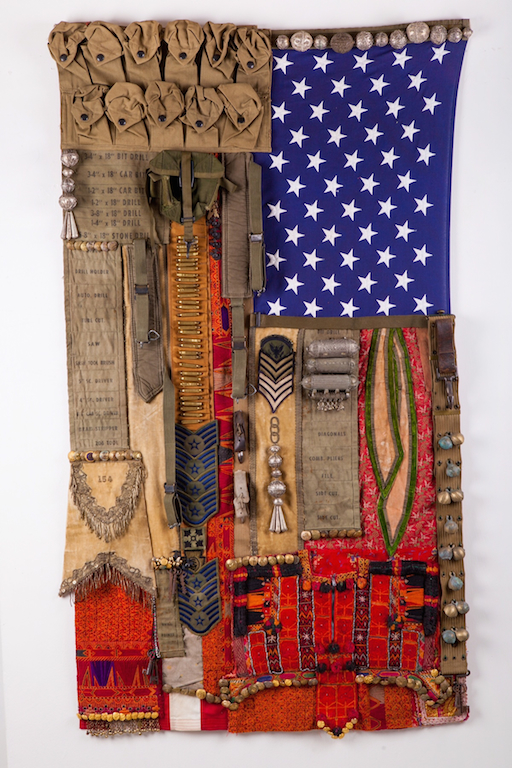 [Flag #6, Decaying confidant, you brought me to my knees (2007-2013). Image copyright Sara Rahbar. Courtesy of the artist and Carbon 12, Dubai.]
[Flag #6, Decaying confidant, you brought me to my knees (2007-2013). Image copyright Sara Rahbar. Courtesy of the artist and Carbon 12, Dubai.]
DL: Out of the corner of my eye I keep checking on Do you love me from across the gallery, and waiting for its feet to begin scuttling across the concrete floor.
SR: Originally this piece was meant to be installed on the wall, so that the feet would never touch the ground and remain in a frozen state of anxiety and “waiting.” The feet are controlled by the object above them, which moves them in different positions and directions. I battle feeling awkward and uncomfortable in my own skin on a daily basis, feeling restless, irritable and lost, and I’m addressing those feelings in this piece.
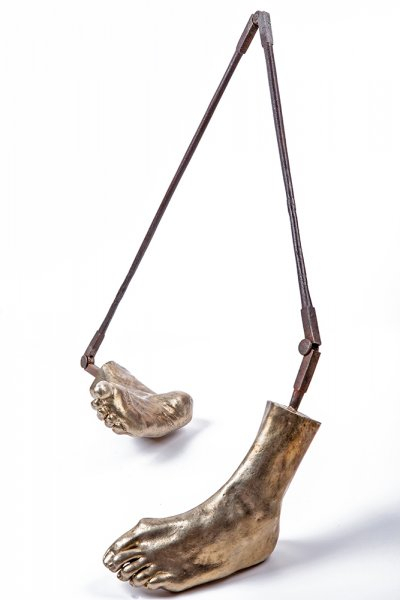 [do you love me (2013), from the confessions series. Image copyright Sara Rahbar. Courtesy of the artist and Carbon 12, Dubai.]
[do you love me (2013), from the confessions series. Image copyright Sara Rahbar. Courtesy of the artist and Carbon 12, Dubai.]
DL: Are you uncomfortable now?
SR: I’m always uncomfortable and there is a very angry, negative, and judgmental voice in my head on a daily basis, which causes me a lot of angst. Making art is the only thing that makes sense to me and allows me to go on from one day to the next. Sometimes while I’m in the studio I play recordings of Sylvia Plath’s poetry readings and it calms me somehow. I’ve battled depression my entire life and art has been one of the few things I have found that has helped me tremendously. Seeing it, being around it and making it, gives me purpose and hope.
DL: If you somehow banished that voice how would it change your practice?
SR: I can’t even imagine being without that voice. Maybe I’d start to paint flowers?